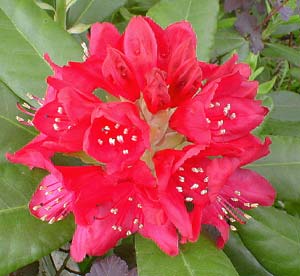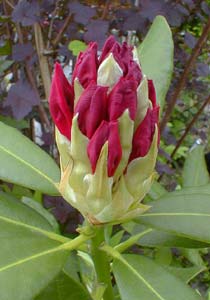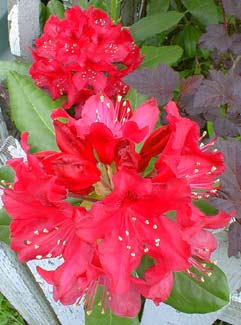 Rhododendron catawbiense grandiflorum 'Nova Zembla'
Rhododendron catawbiense grandiflorum 'Nova Zembla'
"When the storm was in the sky,
And the west was black with showers,
My Beloved came by
With His Hands full of flowers -
Red burning flowers,
Like flame that pulsed & throbbed -
And beyond in the rain-smitten bowers
The turtle-dove sobbed."
-May Probyn,
1870s
1870s
When the rhododendron hybrid 'Nova Zembla' is grown in full shade, it gets a bit thinly leafed & attractively reveals its structure, but also doesn't set buds very quickly. In a goodly portion of sunlight it becomes densely leafed so that you cannot see the interesting bark & sturdy limbs, but it sets enormous buds.
I bought a small specimen at about three feet tall but with very rugged looking stems, as it had been rooted from a large cutting of a mature shrub. There were many other specimens to choose from, all of them on sale cheaply. Many were very large & bushy for the price, but I chose a comparatively leggy one that had been stuck too long in deep shade. I was simply attracted to the revealed forked trunks & an interesting "lean," so chose it over many larger, leafier ones of the same price, which seemed to surprise the vendor who said something about my taking pity on an orphan. But I hadn't taken pity at all; the bushier ones looked too ordinary to me.
 I selected a position for it at the corner of the yard where it got shade the first half of the day, & considerable sunlight all afternoon, though hemmed in & protected by other shrubs, undoubtedly overcrowded. This position seemed likely to get it leafy again, since if the sun is right, Nova Zembla has a tendency toward mounding upright form with compact foliage, but I was even so hoping it would remain a bit airy & open to reveal its limbs.
I selected a position for it at the corner of the yard where it got shade the first half of the day, & considerable sunlight all afternoon, though hemmed in & protected by other shrubs, undoubtedly overcrowded. This position seemed likely to get it leafy again, since if the sun is right, Nova Zembla has a tendency toward mounding upright form with compact foliage, but I was even so hoping it would remain a bit airy & open to reveal its limbs.Its first year it did not flower because of the nursery having had it over a year in deep shade under a heavily vined pergola, hence it had set no buds. In only one year it grew more than a foot taller, a swifter growth than is typical, very likely because it expended no energy on blooms while yet finding itself in a much more encouraging setting. By its second year it had leafed out, & developed huge fat terminal buds that toward the end of May began to show red in the cracks. For such a young plant it bloomed extravagantly at May's end & for June.
R. catawbiense is native of the Appalachian mountains from Virginia to Georgia, a species that has been signal in the development of hardy large-leaf American hybrids collectively known as "Iron Clads" because they are so difficult to fail with. The species can get to be twenty feet in height although the Nova Zembla hybrid will only be six to eight feet in ten years.
 It's specific hybrid history of this 1902 shrub is only half known. It was developed by the Dutch firm of M. Koster & Sons, by crossing Anthony Waterer's ultra-hardy 1860 classic Ironclad 'Parson's Grandiflorum' with a nameless hardy red. The resultant shrub proved so hardy it was destined to become a standard choice for less than ideal gardening conditions. The Koster plant-breeding dynasty tried the same cross again, resulting in the 1920 hardy red called 'America.'
It's specific hybrid history of this 1902 shrub is only half known. It was developed by the Dutch firm of M. Koster & Sons, by crossing Anthony Waterer's ultra-hardy 1860 classic Ironclad 'Parson's Grandiflorum' with a nameless hardy red. The resultant shrub proved so hardy it was destined to become a standard choice for less than ideal gardening conditions. The Koster plant-breeding dynasty tried the same cross again, resulting in the 1920 hardy red called 'America.'Typical of the Iron Clads, 'Nova Zembla' develops a stout trunk (or trunks) with thick stems, the bark becoming scaly & very attractive with age. The blooms are large, five inches wide or wider, with big leaves proportional to bloom.
The huge trusses of blooms are a deep, nearly bluish red, with some darker spotting on the upper inner petal. Though ours bloomed a month later than is typical, in most cases 'Nova Zembla' blooms in late April through May.
Removal of spent blossoms encourages 'Nova Zembla' in occasional specimens to rebloom in late summer or early autumn, though ours has not done so. Capacity to rebloom is a feature almost unheard of among rhododendrons, though we've another Ironclad, 'Lee's Best Purple,' which reliably reblooms for us every Autumn.
Anyone fearful of being able to take perfect care of a rhody will have no worries with this one. It is an old garden hybrid that has proven its value over time. This Catawba hybrid it is cold hardy to minus 25, plus tolerant of heat & sun (even if dappled shade for part of the day might suit it better).
'Nova Zembla' means "New Land." The rhododendron is named for the island of that name off the northern coast of Russia. In the 16th Century the island of Nova Zembla was a veritable haven for mariners seeking a polar route from Europe to Asia. Under ideal conditions such a route was found to exist, though ice flows meant that many a far-exploring ship was crushed.
For more photographs of this shrub, go to the:
'Nova Zembla' Page of the Rhododendron Gallery